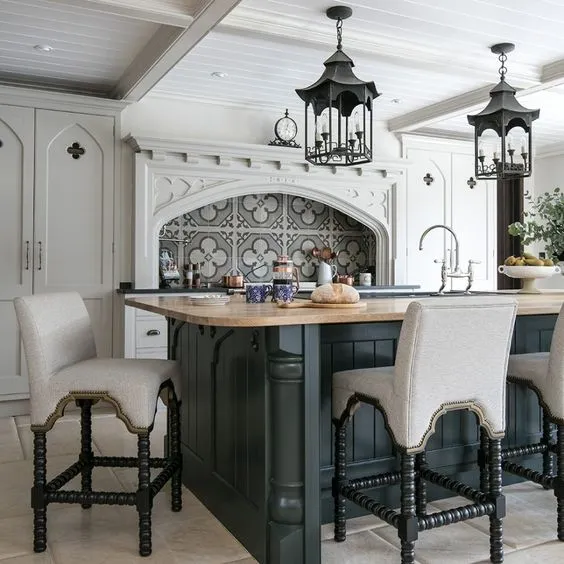Gothic Kitchen Decor Introduction
Transforming your kitchen into a gothic haven can be an exciting endeavor, offering a unique blend of historical elegance and dramatic flair. This guide will help you navigate the world of gothic kitchen decor, providing you with the knowledge and inspiration needed to create a space that reflects your dark yet sophisticated tastes. From choosing the right color palettes and furniture to selecting the perfect accessories and lighting, we will cover all the essential elements required to achieve the ideal gothic aesthetic. Get ready to immerse yourself in the world of dramatic shadows, ornate details, and a touch of mystery, all while making your kitchen the most enchanting room in your home. Gothic kitchen decor is about creating a space that feels both inviting and intriguing, a true reflection of your personality.
Embracing the Gothic Kitchen Aesthetic
The gothic aesthetic is characterized by its dramatic, mysterious, and often ornate elements. Think of the architecture of medieval cathedrals, with their pointed arches, stained-glass windows, and imposing structures. Translating this to a kitchen means incorporating dark colors, rich textures, and historical-inspired details. It’s a style that embraces shadows and creates an atmosphere of intrigue and elegance. The key is to find a balance between the dramatic and the functional. You want a space that feels both luxurious and livable, where every element contributes to the overall gothic ambiance. This style often incorporates elements of Victorian and Renaissance design, using dark woods, elaborate carvings, and antique-inspired accents to achieve a truly unique look. This is about creating a kitchen that is both beautiful and a reflection of a deep sense of history and artistry.
Key Elements of Gothic Decor
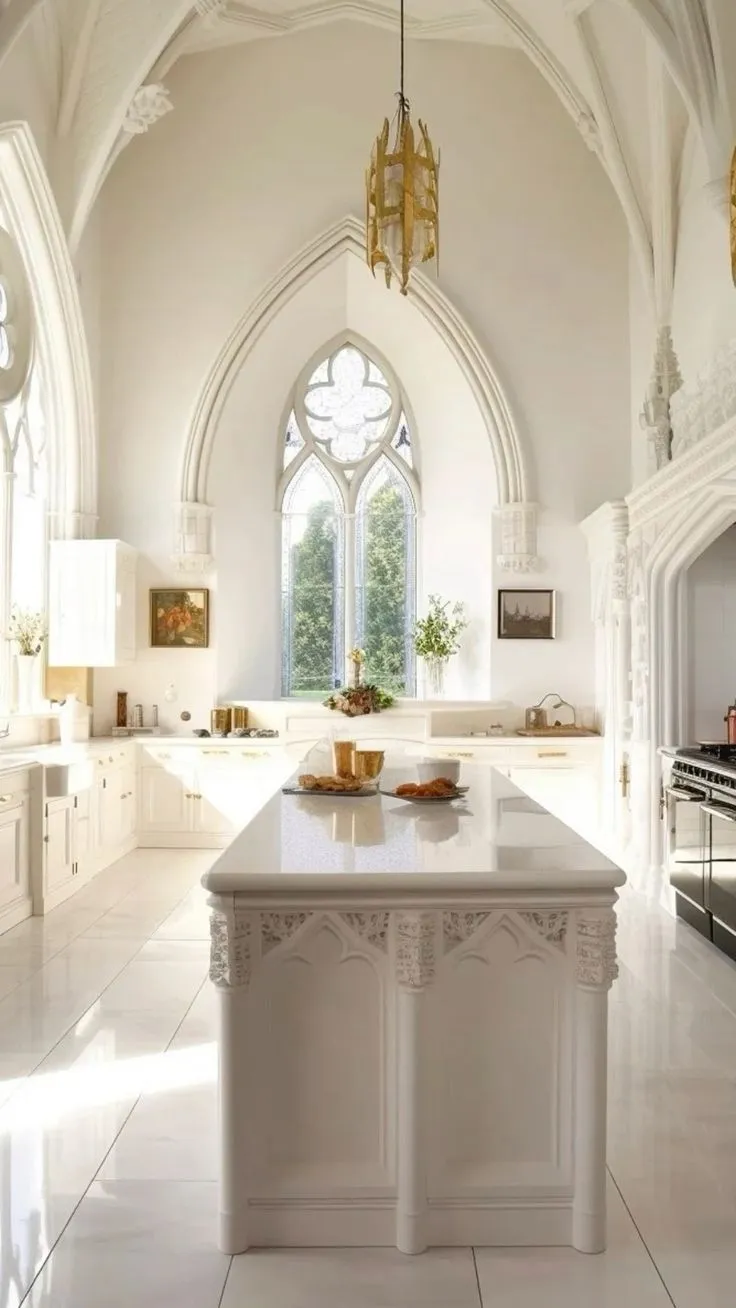
Several key elements define gothic decor, and incorporating these will ensure your kitchen embodies the true spirit of the style. First, consider the color palette, which typically revolves around deep, rich hues. Dark shades of gray, black, and burgundy form the foundation, with accents of gold, silver, or jewel tones to add a touch of opulence. Furniture often features dark woods, detailed carvings, and imposing silhouettes. Think of high-backed chairs, ornate tables, and cabinets with intricate designs. Lighting is another critical element; chandeliers, sconces, and pendant lights with a vintage or antique feel create a dramatic ambiance. Accessories such as candelabras, ornate mirrors, and gothic-inspired artwork further enhance the look. Texture plays a crucial role, with velvet, brocade, and other luxurious fabrics adding depth and interest. By focusing on these elements, you’ll be well on your way to creating a captivating gothic kitchen.
Color Palette for a Gothic Kitchen
The color scheme is fundamental to establishing the gothic atmosphere. Deep, saturated colors create a sense of drama and sophistication. Consider using a base of charcoal gray or black for walls and cabinets to set the tone. This will create a moody yet elegant foundation. Dark burgundy or a deep forest green can also be used as primary colors, offering a rich and inviting atmosphere. The goal is to create a space that feels intimate and intriguing, embracing the shadows and highlighting the details that make the gothic style unique. Avoid overly bright or cheerful colors; instead, opt for tones that evoke a sense of mystery and grandeur. These colors provide a perfect backdrop for your furniture and decor, allowing the intricate details to stand out and create a visually striking effect.
Dark and Dramatic Colors
Embrace the darkness! Deep blacks, charcoal grays, and even navy blues are your allies when establishing a gothic kitchen. These colors can be used on walls, cabinets, or even the flooring. Black cabinets, for example, can create a stunning contrast against lighter countertops and backsplashes. Charcoal gray walls provide a moody backdrop that allows ornate furniture and decor to stand out. Navy blue, a more subtle option, can bring depth and sophistication to the space. These colors will create a kitchen that feels both intimate and luxurious. Ensure that the lighting is well-planned to prevent the space from feeling too dark. Use a combination of ambient, task, and accent lighting to highlight key features and add layers of illumination.
Accent Colors to Enhance Gothic Style
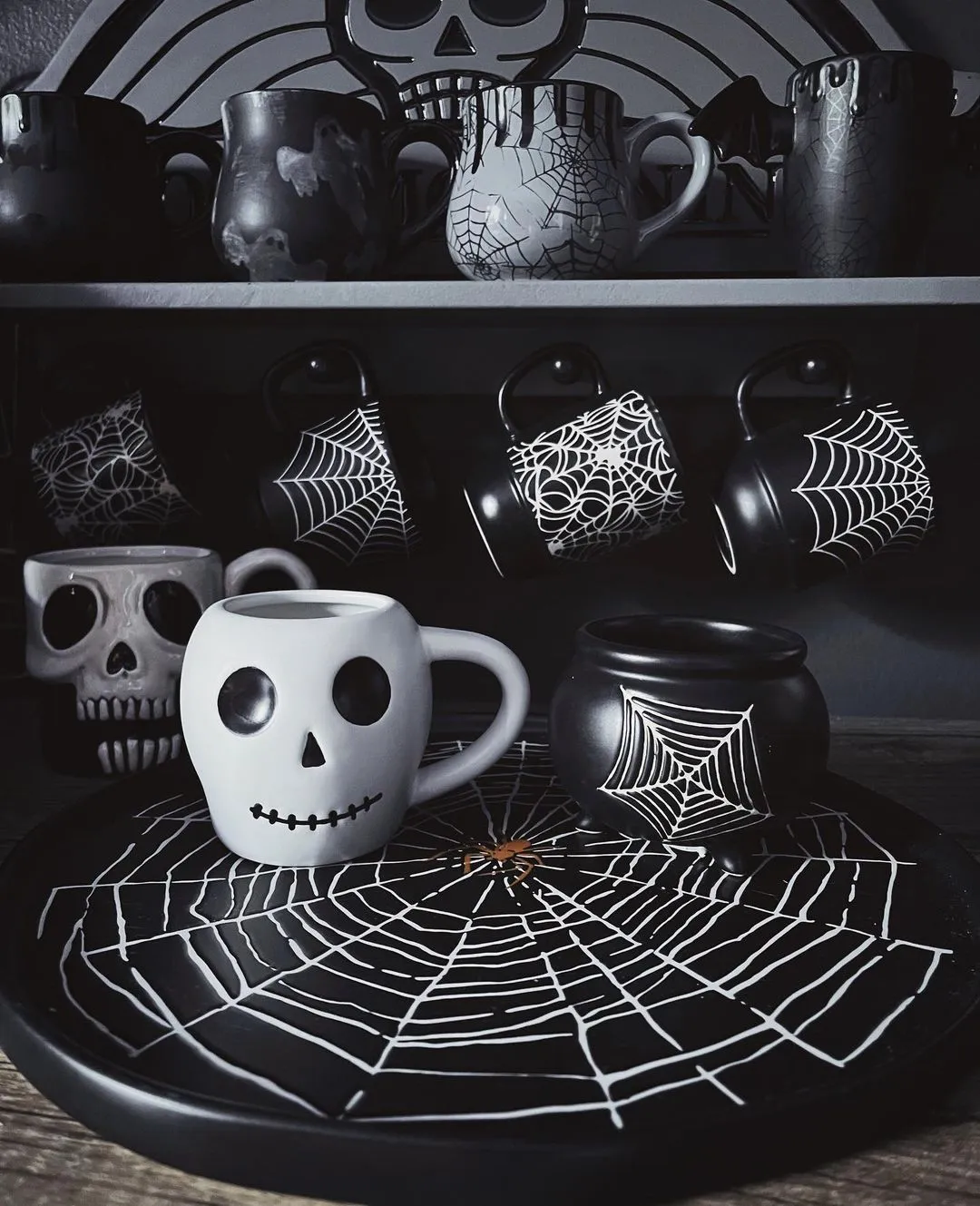
While the primary colors are dark, accent colors bring vibrancy and depth. Gold, silver, and bronze metallics can be used on cabinet hardware, light fixtures, and decorative accessories. These accents add a touch of opulence and contrast against the darker tones. Jewel tones like deep emerald green, ruby red, or amethyst purple can also be incorporated through textiles, artwork, or decorative pieces. These colors will add visual interest and create a sense of luxury. The strategic use of these accents is critical to preventing the space from feeling overly somber. They should be used sparingly to create a visually appealing and balanced design. The interplay of dark and light adds a dramatic flair.
Furniture Selection for a Gothic Kitchen
Choosing the right furniture is essential to capture the gothic aesthetic. The goal is to select pieces with a sense of history, ornate detailing, and a touch of drama. Look for furniture made from dark woods like mahogany or walnut, known for their rich color and intricate grain patterns. The lines should be strong and imposing. Consider the materials and their impact on the overall feeling of the space. The furniture will set the mood of your kitchen and reflect the style you desire. The selection will also impact the use and functionality of your kitchen space, ensure that each piece of furniture combines elegance with practicality to create a harmonious and functional design.
Choosing the Right Kitchen Cabinets
Kitchen cabinets are a central element. Select cabinets with detailed carvings, raised panels, or gothic arch designs. Dark-stained wood is ideal, and consider using black or charcoal gray for a dramatic effect. Hardware is equally important; opt for ornate pulls, knobs, or hinges in bronze, brass, or iron. These details can add a layer of elegance. Consider the layout of your cabinets and how they will interact with the rest of the kitchen. The design of the cabinets significantly impacts the overall look of your kitchen. Choose options that blend function and beauty. The style and finish of your cabinets will be a significant factor in establishing the gothic kitchen aesthetic. The intricate design of the cabinets can dramatically change the look of your kitchen.
Gothic-Inspired Table and Chairs
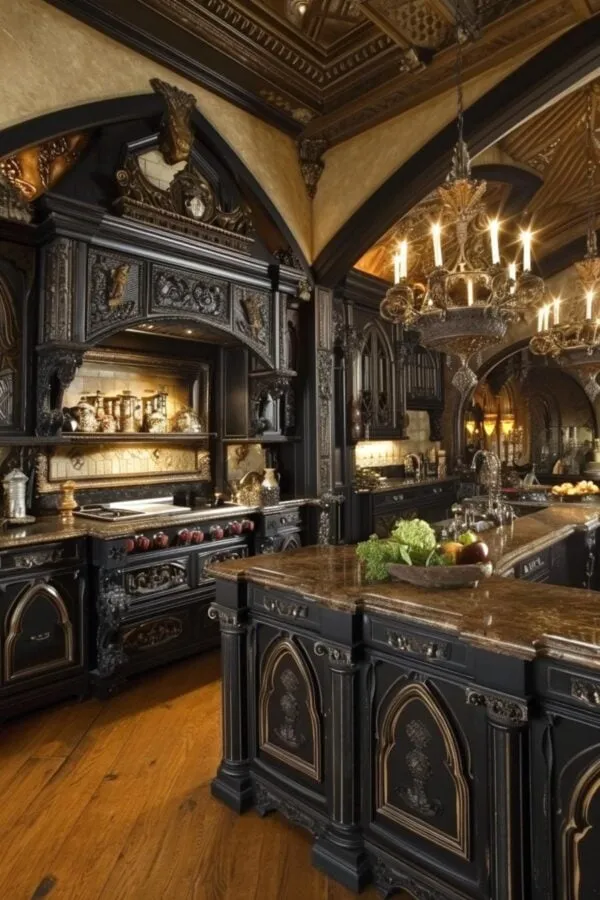
The dining area within your gothic kitchen should reflect the overall theme. Choose a large, dark wood table with a sturdy base and possibly carved details. The chairs should be equally dramatic, with high backs, detailed carvings, and upholstery in rich fabrics like velvet or leather. Look for chairs with armrests, which can add a sense of formality. Consider the shape of the table; a rectangular or oval table is a classic choice. For a more intimate setting, a round table can create a sense of closeness. The goal is to create a space that is both inviting and elegant, perfect for dining and entertaining. These furniture pieces will not only serve a practical function but also contribute to the aesthetic of your gothic kitchen.
Lighting Design in Gothic Kitchens
Lighting plays a critical role in gothic kitchens. It sets the ambiance and highlights the design details. The key is to layer different types of lighting to create a warm, inviting, and dramatic atmosphere. Consider chandeliers, pendant lights, and sconces for a touch of vintage elegance. Ambient lighting is essential to set the mood, while task lighting ensures the kitchen is functional. Carefully consider the placement of lights and how they affect the shadows and highlights in the space. The interplay of light and shadow is a hallmark of the gothic style, so use lighting to create a sense of mystery and intrigue. The right lighting is key to capturing the essence of your gothic kitchen. With proper lighting design, you can truly elevate your kitchen to a whole new level.
Chandeliers and Pendant Lights
A dramatic chandelier is a signature element of gothic kitchens. Choose a design with intricate details, such as wrought iron, crystals, or ornate metalwork. Place the chandelier above the kitchen island or dining table to create a focal point. Pendant lights can complement the chandelier, providing additional task lighting. Choose pendant lights with a vintage or antique feel, such as those with a dark metal finish or a textured glass shade. Ensure that the lights are the right size for your kitchen. The chandelier and pendant lights will not only add style but also provide essential illumination for everyday use. The right lighting fixtures will draw the eye and enhance the gothic vibe. They will highlight architectural features and make your kitchen feel more elegant.
Ambient Lighting for a Spooky Ambiance
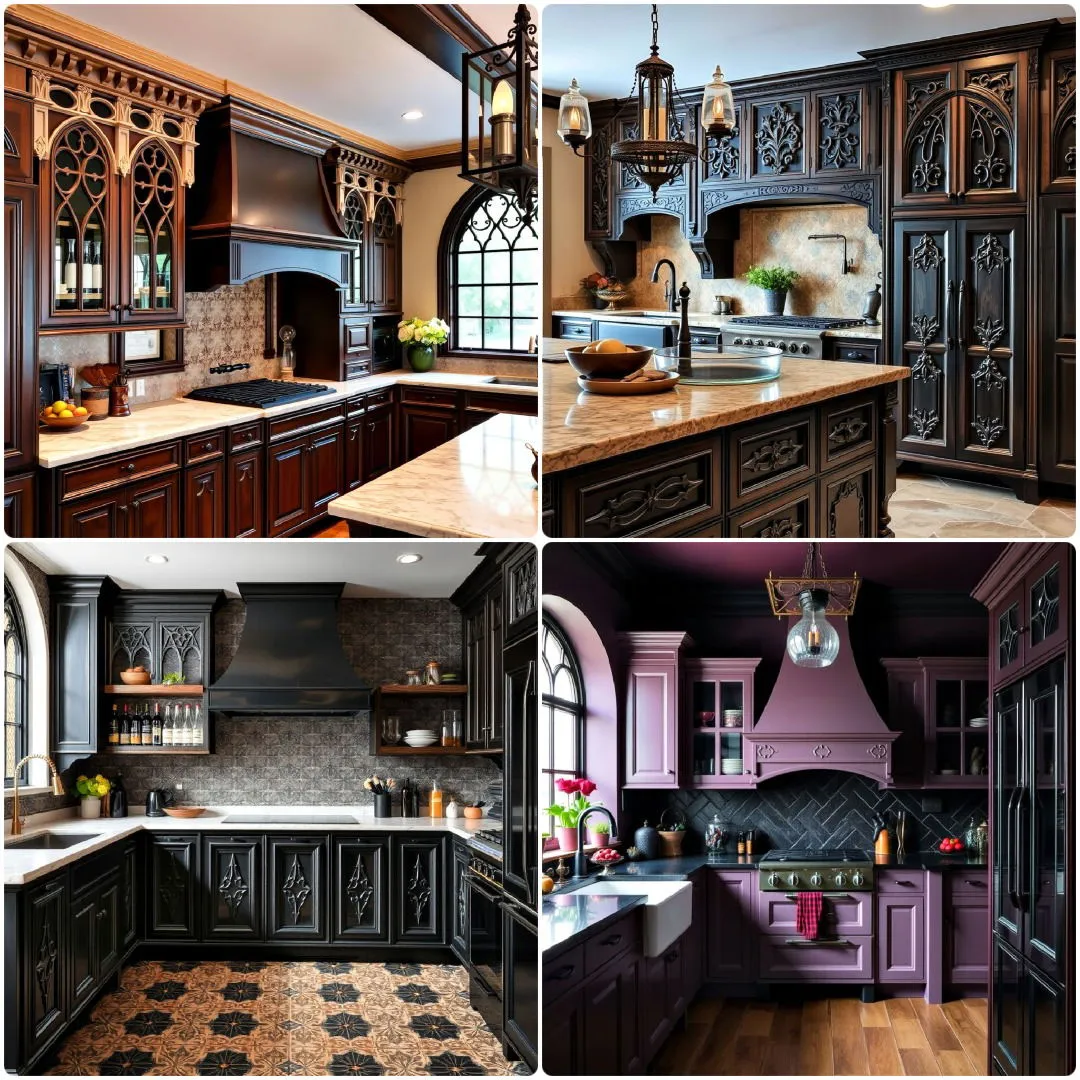
In addition to task and decorative lighting, ambient lighting is essential to set the mood. Install sconces on the walls or above the cabinets to create soft, diffused light. Consider using dimmer switches to adjust the intensity of the light and create a sense of mystery. Candles, either real or electric, can also be used to add warmth and ambiance. Place them on the countertops, shelves, or dining table. The strategic use of ambient lighting will transform your kitchen into a space that is both inviting and intriguing. The shadows and highlights created by the lighting will enhance the architectural features and the textures and colors of the room. Carefully placed ambient lighting can set a cozy and welcoming environment.
Decorative Accessories in a Gothic Kitchen
Accessories are the finishing touches that bring your gothic kitchen to life. They should reflect the overall style and create a sense of drama and intrigue. Consider the objects that will complement the colors, furniture, and lighting. These details complete the aesthetic and ensure your kitchen is the most intriguing space. Choose items that add visual interest, evoke a sense of history, and highlight the gothic theme. It is essential to create a sense of cohesion through your accessories, ensuring the various elements work together to create a cohesive space. The accessories that you select are crucial to personalizing your space and establishing a gothic aesthetic.
Adding Gothic-Themed Decor
Incorporate gothic-themed decor such as candelabras, ornate mirrors, and antique-inspired artwork. Place a large, ornate mirror on a wall to reflect light and create the illusion of more space. Candelabras, either real or electric, add a touch of drama and romance. Antique-inspired artwork, such as portraits or landscapes in dark, ornate frames, can enhance the gothic feel. Other ideas include wrought iron accents, antique books, and decorative boxes. Select items that reflect your personal style and taste. The accessories you choose can make your kitchen feel unique. Use these elements to enhance your space, adding a touch of historical elegance, and intrigue. The details you add make your kitchen a space that is both beautiful and reflective of your personality.
Textiles and Fabrics for Kitchen Decor
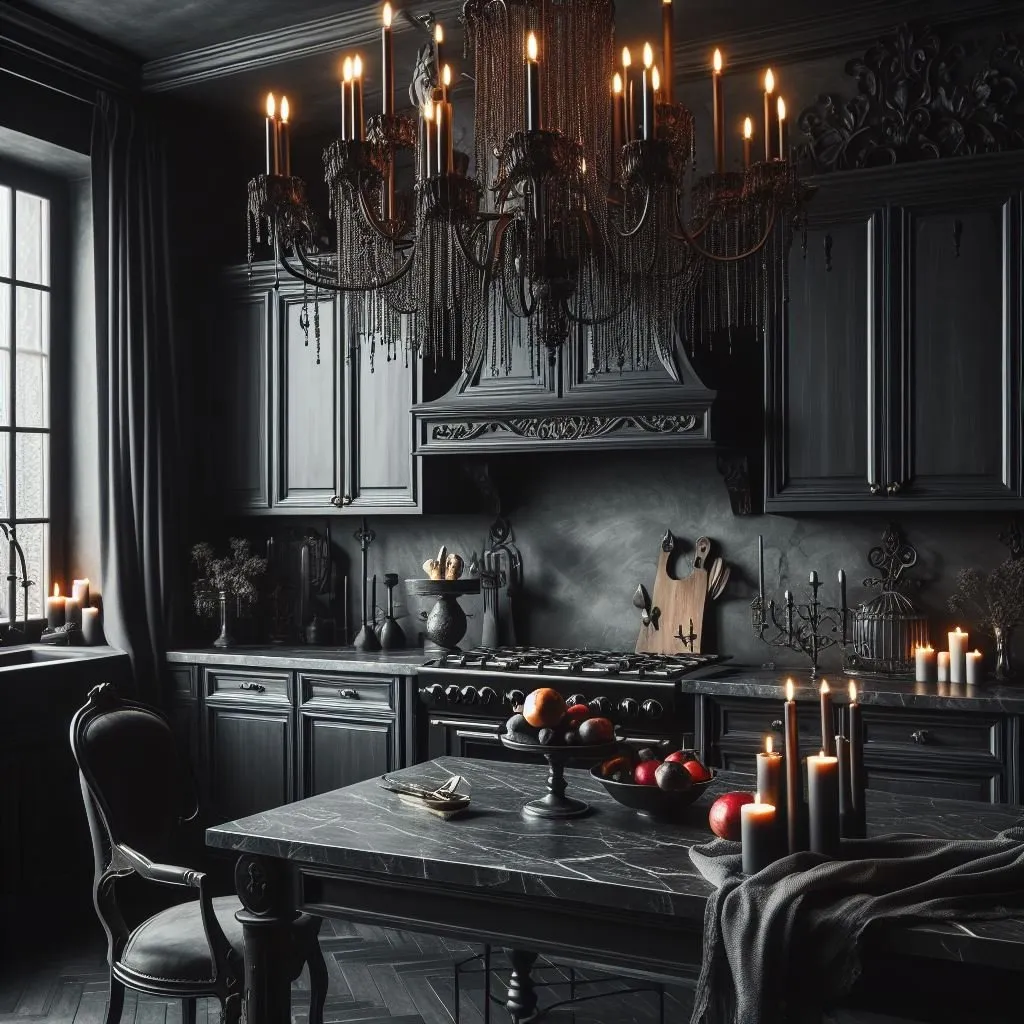
Textiles and fabrics play a significant role in adding depth and texture to your gothic kitchen. Use rich fabrics like velvet, brocade, or damask for your chair upholstery or window treatments. Choose fabrics in dark, saturated colors or with ornate patterns. Consider a textured wallpaper or a fabric-covered backsplash to add visual interest. These details add a layer of sophistication. The use of textiles helps to soften the space and create a sense of luxury. The materials and colors that you select should complement the overall gothic theme. The use of fabrics can transform your kitchen. Think of these textiles as a way to personalize the space, and add extra interest.
Flooring and Surface Choices
The flooring and countertops in your gothic kitchen should reflect the overall style. Dark, rich materials create a sense of drama and sophistication. Think of materials that evoke a sense of history, elegance, and a touch of mystery. The materials should be durable and functional. The choice of materials is very important. The selection will impact the look of the space, and influence the atmosphere that you hope to establish. Choosing wisely here will help to enhance the gothic theme and create a cohesive design.
Flooring Options
Consider dark-stained hardwood floors, or if you prefer, explore options. Tile flooring in dark colors, or with an intricate pattern, can also create a striking effect. Another alternative is to use patterned tile or stone. The flooring contributes to the overall aesthetic of the kitchen. Avoid overly bright or modern flooring choices. Think of the look you want to achieve, and choose materials that will help you achieve your goals. It is essential that the flooring complements the other elements of your kitchen. The flooring you select is going to make a big impact on the look of your kitchen. Proper choices are going to reinforce the gothic style.
Countertop Materials
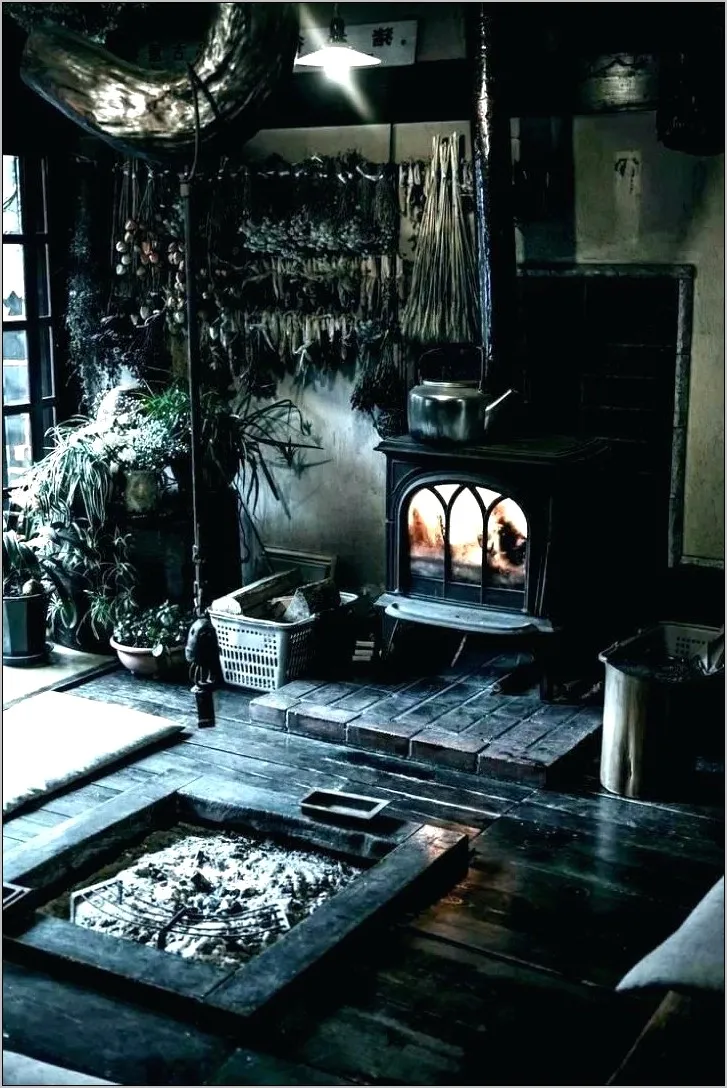
For countertops, consider granite or quartz in dark colors like black or charcoal gray. These materials are durable and add a touch of elegance. Consider the texture; a honed finish creates a more understated look, while a polished finish adds more shine. Other options include marble, which can give a luxurious touch. The countertop materials are crucial to the functionality of the kitchen. The colors and the materials should be chosen to complement the flooring, the cabinets, and the overall gothic aesthetic. Make sure you choose materials that are both attractive and practical for everyday use. The right countertops can enhance the gothic appeal. They will complement the other elements of the space.
Gothic Kitchen Decor Conclusion
Creating a gothic kitchen is about embracing a unique blend of historical elegance and dramatic flair. By focusing on key elements like the color palette, furniture, lighting, and accessories, you can transform your kitchen into a space that reflects your dark yet sophisticated tastes. The goal is to create a space that is both inviting and intriguing, a true reflection of your personality and design vision. Don’t be afraid to experiment with different elements, and add your personal touches. The process of creating your gothic kitchen decor should be both enjoyable and rewarding. Embrace the shadows, revel in the drama, and create a kitchen that is as unique and captivating as you are. Your gothic kitchen will be a space that is both beautiful and a true reflection of your creativity and sense of style.
